 The two most prominent landmarks in the 7th Arrondissement: the Eiffel Tower and the gilded dome of Invalides, along with the large open space parks around them, are high points of this tour.
The two most prominent landmarks in the 7th Arrondissement: the Eiffel Tower and the gilded dome of Invalides, along with the large open space parks around them, are high points of this tour.Paris’ Seventh Arrondissement is one of the “newer” neighborhoods in the city. By that, I mean that it was an area outside the defensive walls of the historical city. Late in the 17th century, Louis XIV began construction of the veterans’ home, Les Invalides, on the plain of Grenelle outside the city. Much later, through the 18th and 19th centuries, the area filled in. Today, it is a chic residential quarter chock full of landmarks and monuments.
This tour is, in a way, peculiar since it is a walk backward in time. We’ll start with the Eiffel Tower itself, one of the newest landmarks in the area, and progress backward in time to one of the oldest: the Hôtel des Invalides.
Begin your tour at the Bir Hakeim métro station. Walk upriver, along the Quai Branly toward the Eiffel Tower, and make your way to the space directly under the tower. This is, of course, one of the most visited sites in Paris and you will undoubtedly be part of a crowd.
 The base of the Eiffel Tower and the Champ de Mars beyond.
The base of the Eiffel Tower and the Champ de Mars beyond.With your back to the river, look south-east toward the Ecole Militaire. What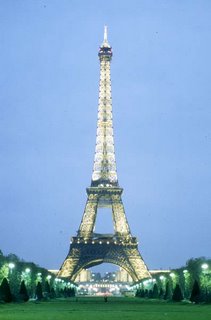 you are seeing is known today as the Champ de Mars. But as late as the 17th century, this was the center of a vast, empty space known as the plain of Grenelle. The plain stretched from what is now the Blvd. des Invalides to the Blvd. de Grenelle and beyond.
you are seeing is known today as the Champ de Mars. But as late as the 17th century, this was the center of a vast, empty space known as the plain of Grenelle. The plain stretched from what is now the Blvd. des Invalides to the Blvd. de Grenelle and beyond.
 you are seeing is known today as the Champ de Mars. But as late as the 17th century, this was the center of a vast, empty space known as the plain of Grenelle. The plain stretched from what is now the Blvd. des Invalides to the Blvd. de Grenelle and beyond.
you are seeing is known today as the Champ de Mars. But as late as the 17th century, this was the center of a vast, empty space known as the plain of Grenelle. The plain stretched from what is now the Blvd. des Invalides to the Blvd. de Grenelle and beyond.This land was part of the holdings of two Paris abbeys: St.-Germain-des-Prés and Ste.-Geneviève, and was a place where people hunted rabbit and quail, or, closer to the river, grew vegetables for sale in the city’s markets. The land nearest the river was marshy, with islands that were later incorporated into the left bank.
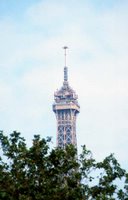 The Eiffel Tower itself is described in great detail in nearly every Paris guidebook. Suffice it to say that it was constructed as part of the Paris Universal Exhibition held in 1889, on the centennial of the French Revolution. Intended as a temporary show of construction technology, the tower has become a permanent fixture on the skyline and in the tourist itineraries and is well worth waiting in the long lines to visit.
The Eiffel Tower itself is described in great detail in nearly every Paris guidebook. Suffice it to say that it was constructed as part of the Paris Universal Exhibition held in 1889, on the centennial of the French Revolution. Intended as a temporary show of construction technology, the tower has become a permanent fixture on the skyline and in the tourist itineraries and is well worth waiting in the long lines to visit.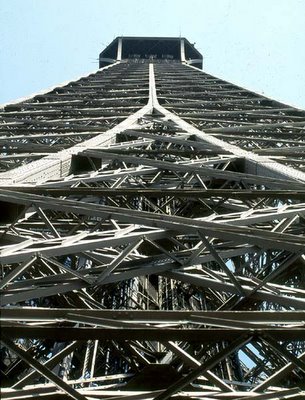
Above, the tower's intricate structure. Below, some of the machinery that powers the elevators that move visitors up and down inside the Eiffel Tower.
 What many guidebooks only touch on is the historical use of the Champ de Mars. When the Ecole Militaire was constructed between 1751 and 1773, the land between it and the Seine was converted to a parade ground for military exercises. After 1780, the land was opened to up to the public. In 1790, the Federation celebration was held here to mark the first anniversary of the storming of the Bastille. Since then, the Champ de Mars has been used for countless celebrations and fairs, including the Universal Expositions of 1867, 1878, 1889, 1900, and 1937.
What many guidebooks only touch on is the historical use of the Champ de Mars. When the Ecole Militaire was constructed between 1751 and 1773, the land between it and the Seine was converted to a parade ground for military exercises. After 1780, the land was opened to up to the public. In 1790, the Federation celebration was held here to mark the first anniversary of the storming of the Bastille. Since then, the Champ de Mars has been used for countless celebrations and fairs, including the Universal Expositions of 1867, 1878, 1889, 1900, and 1937.Walk from the Eiffel Tower across the Champ de Mars toward the Ecole Militaire (in this photo: the Champ de Mars with the Ecole Militaire
 in the center; behind it and to the right is the UNESCO headquarters building). You will notice that the vast park is thoroughly used and enjoyed by tourists and residents alike. When you reach the Ecole Militaire, turn right on the Avenue de la Motte Picquet, then left on the Avenue de Suffren. At the southern corner of the Ecole Militaire, turn left onto the Avenue Lowendal. Across the avenue is the headquarters of UNESCO (United Nations Educational, Scientific and Cultural Organization). The building was completed in 1958 and is the result of collaboration between American, Italian, and French architects (Breuer, Nervi, and Zehrfuss, respectively). The modern building is home to several works of modern art by Picasso, Moore, and others.
in the center; behind it and to the right is the UNESCO headquarters building). You will notice that the vast park is thoroughly used and enjoyed by tourists and residents alike. When you reach the Ecole Militaire, turn right on the Avenue de la Motte Picquet, then left on the Avenue de Suffren. At the southern corner of the Ecole Militaire, turn left onto the Avenue Lowendal. Across the avenue is the headquarters of UNESCO (United Nations Educational, Scientific and Cultural Organization). The building was completed in 1958 and is the result of collaboration between American, Italian, and French architects (Breuer, Nervi, and Zehrfuss, respectively). The modern building is home to several works of modern art by Picasso, Moore, and others.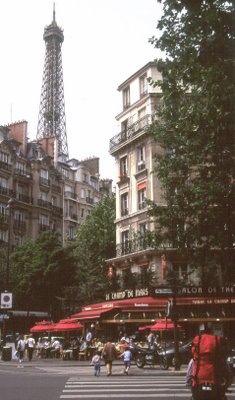 Continue along the Avenue Lowendal, cross the Avenue Duquesne, and proceed to the Avenue de Tourville. Turn right and walk to the semi-circular Place Vauban. By now you have noticed one of the more prominent landmarks of the quarter, the Church of the Dôme at the Hôtel des Invalides. The gilded dome (re-gilt for the bicentennial of the French Revolution in 1989) glistens in the sun and marks the final resting place of the emperor Napoléon Bonaparte.
Continue along the Avenue Lowendal, cross the Avenue Duquesne, and proceed to the Avenue de Tourville. Turn right and walk to the semi-circular Place Vauban. By now you have noticed one of the more prominent landmarks of the quarter, the Church of the Dôme at the Hôtel des Invalides. The gilded dome (re-gilt for the bicentennial of the French Revolution in 1989) glistens in the sun and marks the final resting place of the emperor Napoléon Bonaparte.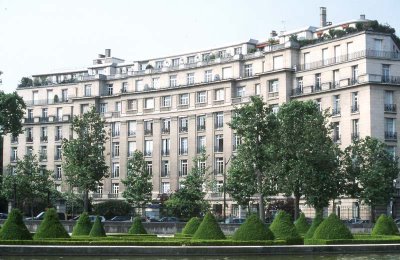 The elegant Place Vauban. Above: a residential building. Below: getting ready for lunch at Le Vauban.
The elegant Place Vauban. Above: a residential building. Below: getting ready for lunch at Le Vauban.
 The vast complex that surrounds the church is worthy of an extended visit. In addition to Napoléon’s tomb in the Church of the Dôme (seen at right), you will find another church (Eglise St. Louis), the national Army Museum that chronicles military history, uniforms, arms and other equipment and a fascinating collection of model forts, fortified cities and towns, and significant battlefields (Musée des Plans Relief) that spans three centuries.
The vast complex that surrounds the church is worthy of an extended visit. In addition to Napoléon’s tomb in the Church of the Dôme (seen at right), you will find another church (Eglise St. Louis), the national Army Museum that chronicles military history, uniforms, arms and other equipment and a fascinating collection of model forts, fortified cities and towns, and significant battlefields (Musée des Plans Relief) that spans three centuries. The complex was begun under Louis XIV in 1670. Its purpose was to house veterans of war that were injured in service to the king (les invalides). Near its completion, it welcomed nearly 4,000 veterans. The place was pillaged during the revolution in 1789, mostly for the weapons that were stored in the basements.
The complex was begun under Louis XIV in 1670. Its purpose was to house veterans of war that were injured in service to the king (les invalides). Near its completion, it welcomed nearly 4,000 veterans. The place was pillaged during the revolution in 1789, mostly for the weapons that were stored in the basements.From the Place Vauban, continue along the Avenue de Tourville to the Boulevard des Invalides and turn left. Turn right into the rue de Varenne. Here is the entrance to the Hôtel Biron, home to the Rodin Museum. Auguste Rodin left his work to France in exchange for a place to live and work in this 18th century mansion. The gardens around the house make for an enjoyable stroll and serve as a striking setting for many of Rodin’s famous sculptures. Inside the building are many more of Rodin’s works. There is an admission fee for both the garden and the building.
 The gardens and the Rodin Museum. If you enlarge the photo (click on it), you can make out the famous statue Le Penseur (The Thinker) in the garden just to the left of the house.
The gardens and the Rodin Museum. If you enlarge the photo (click on it), you can make out the famous statue Le Penseur (The Thinker) in the garden just to the left of the house.Return to the Boulevard des Invalides and continue around the the Hôtel des Invalides to the vast grassy
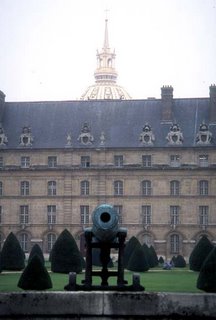 area between it and the Seine. The Esplanade is bisected by the Avenue du Maréchal Galliéni, which connects the Invalides to the Pont Alexandre III. Walk about halfway toward the Seine (notice the glass roof of the Grand Palais on the right bank) and turn left on the rue Saint Dominique. Walk back toward the Eiffel Tower along the rue Saint Dominique into the heart of the residential portion of the 7th Arrondissement. On this street and those surrounding it you will find numerous shops, boutiques and restaurants. Some are well known, like the Restaurant Thoumieux or the shop of famed baker Jean-Luc Poujauran (on the rue Jean Nicot).
area between it and the Seine. The Esplanade is bisected by the Avenue du Maréchal Galliéni, which connects the Invalides to the Pont Alexandre III. Walk about halfway toward the Seine (notice the glass roof of the Grand Palais on the right bank) and turn left on the rue Saint Dominique. Walk back toward the Eiffel Tower along the rue Saint Dominique into the heart of the residential portion of the 7th Arrondissement. On this street and those surrounding it you will find numerous shops, boutiques and restaurants. Some are well known, like the Restaurant Thoumieux or the shop of famed baker Jean-Luc Poujauran (on the rue Jean Nicot).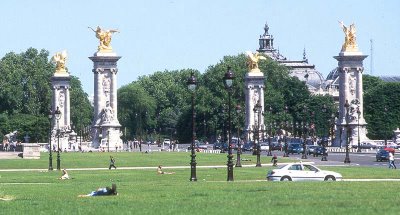 Lying in the grassy Esplanade. The columns of the Alexander III Bridge rise up to mark the Seine River.
Lying in the grassy Esplanade. The columns of the Alexander III Bridge rise up to mark the Seine River.Continue on the rue Saint Dominique to the rue Cler, and turn left. For many Americans, the rue Cler was made famous by travel writer Rick Steves. This is one of the many market streets in Paris, lined with bakeries, cheese shops, vegetable stands, wine shops, butchers, delis, purveyors of table linens and kitchen tools, cafés, and newsstands. Every day is market day on the rue Cler, and Parisians living in the surrounding upper middle class neighborhoods come here daily to buy food. Now, of course, so do many tourists, and the cafés and shops are showing signs of catering to them as much as to locals. But the rue Cler is still a pleasant walk and one of many ways to see how Parisians shop. Stop here for a drink, or a bite to eat.
Below, images from the rue Cler.
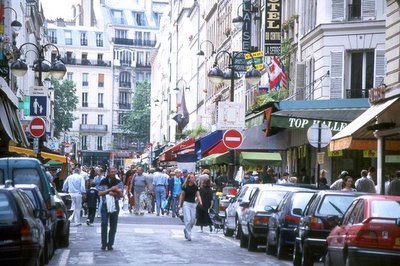


From the rue Cler, you can head in any direction, back to the Eiffel Tower, over to the Seine for a walk along the river, or farther afield to the right bank or into the solidly residential neighborhoods of the 15th Arrondissement.
 Strolling along the Seine on the left bank.
Strolling along the Seine on the left bank.This is the final tour in my little series. I hope you enjoyed them. I'd appreciate any comments you have! Thanks.










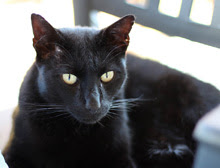


No comments:
Post a Comment
Tell me what you think!